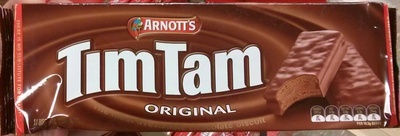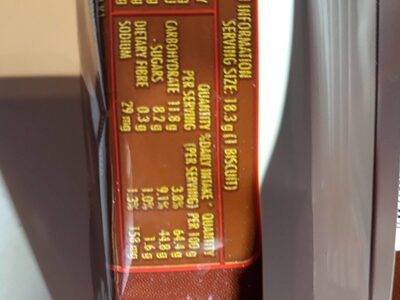Help us make food transparency the norm!
As a non-profit organization, we depend on your donations to continue informing consumers around the world about what they eat.
The food revolution starts with you!
Tim Tam Original Biscuits - Arnott's - 200 g
Tim Tam Original Biscuits - Arnott's - 200 g
This product page is not complete. You can help to complete it by editing it and adding more data from the photos we have, or by taking more photos using the app for Android or iPhone/iPad. Thank you!
×
Barcode: 9310072000282 (EAN / EAN-13)
Quantity: 200 g
Packaging: en:Plastic
Brands: Arnott's
Categories: en:Snacks, en:Sweet snacks, en:Biscuits and cakes, en:Biscuits, en:Cakes, en:Chocolate biscuits, en:Milk chocolate biscuits
Labels, certifications, awards:
en:Australian made, Health Star Rating, Health Star Rating 0.5
Manufacturing or processing places: Australia
Link to the product page on the official site of the producer: https://www.arnotts.com/brands/tim-tam
Stores: Carrefour, Woolworths, Coles, Drakes
Countries where sold: Ahitereiria, Wīwī, en:New Caledonia, Aotearoa
Matching with your preferences
Health
Ingredients
-
23 ingredients
Reo Pākehā: Milk Chocolate (38%)Sugar, Milk Solids, Cocoa Butter, Cocoa Mass Vegetable Oil, Emulsifiers (Soy Lecithin, E476), Flavour), Wheat Flour, Sugar, Vegetable Oil (Contains Soy), Golden Syrup, Food Colours (Caramel III, Beet Red, Cochineal, Annatto), Cocoa Powder, Salt Baking Powder, Emulsifier (Soy Lecithin) Flavour.Allergens: en:Eggs, en:Gluten, en:Milk, en:Nuts, en:Peanuts, en:Sesame seeds, en:SoybeansTraces: en:Eggs, en:Gluten, en:Milk, en:Nuts, en:Peanuts, en:Sesame seeds, en:Soybeans
Food processing
-
Ultra processed foods
Elements that indicate the product is in the en:4 - Ultra processed food and drink products group:
- Additive: E120
- Additive: E160b
- Additive: E322
- Additive: E476
- Ingredient: Emulsifier
- Ingredient: Flavouring
- Ingredient: Invert sugar
Food products are classified into 4 groups according to their degree of processing:
- Unprocessed or minimally processed foods
- Processed culinary ingredients
- Processed foods
- Ultra processed foods
The determination of the group is based on the category of the product and on the ingredients it contains.
Additives
-
E120
Carminic acid: Carminic acid -C22H20O13- is a red glucosidal hydroxyanthrapurin that occurs naturally in some scale insects, such as the cochineal, Armenian cochineal, and Polish cochineal. The insects produce the acid as a deterrent to predators. An aluminum salt of carminic acid is the coloring agent in carmine. Synonyms are C.I. 75470 and C.I. Natural Red 4. The chemical structure of carminic acid consists of a core anthraquinone structure linked to a glucose sugar unit. Carminic acid was first synthesized in the laboratory by organic chemists in 1991.Source: Wikipedia (Reo Pākehā)
-
E322
Lecithin: Lecithin -UK: , US: , from the Greek lekithos, "egg yolk"- is a generic term to designate any group of yellow-brownish fatty substances occurring in animal and plant tissues, which are amphiphilic – they attract both water and fatty substances -and so are both hydrophilic and lipophilic-, and are used for smoothing food textures, dissolving powders -emulsifying-, homogenizing liquid mixtures, and repelling sticking materials.Lecithins are mixtures of glycerophospholipids including phosphatidylcholine, phosphatidylethanolamine, phosphatidylinositol, phosphatidylserine, and phosphatidic acid.Lecithin was first isolated in 1845 by the French chemist and pharmacist Theodore Gobley. In 1850, he named the phosphatidylcholine lécithine. Gobley originally isolated lecithin from egg yolk—λέκιθος lekithos is "egg yolk" in Ancient Greek—and established the complete chemical formula of phosphatidylcholine in 1874; in between, he had demonstrated the presence of lecithin in a variety of biological matters, including venous blood, in human lungs, bile, human brain tissue, fish eggs, fish roe, and chicken and sheep brain. Lecithin can easily be extracted chemically using solvents such as hexane, ethanol, acetone, petroleum ether, benzene, etc., or extraction can be done mechanically. It is usually available from sources such as soybeans, eggs, milk, marine sources, rapeseed, cottonseed, and sunflower. It has low solubility in water, but is an excellent emulsifier. In aqueous solution, its phospholipids can form either liposomes, bilayer sheets, micelles, or lamellar structures, depending on hydration and temperature. This results in a type of surfactant that usually is classified as amphipathic. Lecithin is sold as a food additive and dietary supplement. In cooking, it is sometimes used as an emulsifier and to prevent sticking, for example in nonstick cooking spray.Source: Wikipedia (Reo Pākehā)
-
E322i
Lecithin: Lecithin -UK: , US: , from the Greek lekithos, "egg yolk"- is a generic term to designate any group of yellow-brownish fatty substances occurring in animal and plant tissues, which are amphiphilic – they attract both water and fatty substances -and so are both hydrophilic and lipophilic-, and are used for smoothing food textures, dissolving powders -emulsifying-, homogenizing liquid mixtures, and repelling sticking materials.Lecithins are mixtures of glycerophospholipids including phosphatidylcholine, phosphatidylethanolamine, phosphatidylinositol, phosphatidylserine, and phosphatidic acid.Lecithin was first isolated in 1845 by the French chemist and pharmacist Theodore Gobley. In 1850, he named the phosphatidylcholine lécithine. Gobley originally isolated lecithin from egg yolk—λέκιθος lekithos is "egg yolk" in Ancient Greek—and established the complete chemical formula of phosphatidylcholine in 1874; in between, he had demonstrated the presence of lecithin in a variety of biological matters, including venous blood, in human lungs, bile, human brain tissue, fish eggs, fish roe, and chicken and sheep brain. Lecithin can easily be extracted chemically using solvents such as hexane, ethanol, acetone, petroleum ether, benzene, etc., or extraction can be done mechanically. It is usually available from sources such as soybeans, eggs, milk, marine sources, rapeseed, cottonseed, and sunflower. It has low solubility in water, but is an excellent emulsifier. In aqueous solution, its phospholipids can form either liposomes, bilayer sheets, micelles, or lamellar structures, depending on hydration and temperature. This results in a type of surfactant that usually is classified as amphipathic. Lecithin is sold as a food additive and dietary supplement. In cooking, it is sometimes used as an emulsifier and to prevent sticking, for example in nonstick cooking spray.Source: Wikipedia (Reo Pākehā)
-
E476
Polyglycerol polyricinoleate: Polyglycerol polyricinoleate -PGPR-, E476, is an emulsifier made from glycerol and fatty acids -usually from castor bean, but also from soybean oil-. In chocolate, compound chocolate and similar coatings, PGPR is mainly used with another substance like lecithin to reduce viscosity. It is used at low levels -below 0.5%-, and works by decreasing the friction between the solid particles -e.g. cacao, sugar, milk- in molten chocolate, reducing the yield stress so that it flows more easily, approaching the behaviour of a Newtonian fluid. It can also be used as an emulsifier in spreads and in salad dressings, or to improve the texture of baked goods. It is made up of a short chain of glycerol molecules connected by ether bonds, with ricinoleic acid side chains connected by ester bonds. PGPR is a yellowish, viscous liquid, and is strongly lipophilic: it is soluble in fats and oils and insoluble in water and ethanol.Source: Wikipedia (Reo Pākehā)
Ingredients analysis
-
en:May contain palm oil
Ingredients that may contain palm oil: en:Vegetable oil
-
en:Non-vegan
Non-vegan ingredients: en:Milk chocolate, en:Milk solids, E120Some ingredients could not be recognized.
We need your help!
You can help us recognize more ingredients and better analyze the list of ingredients for this product and others:
- Edit this product page to correct spelling mistakes in the ingredients list, and/or to remove ingredients in other languages and sentences that are not related to the ingredients.
- Add new entries, synonyms or translations to our multilingual lists of ingredients, ingredient processing methods, and labels.
If you would like to help, join the #ingredients channel on our Slack discussion space and/or learn about ingredients analysis on our wiki. Thank you!
-
en:Non-vegetarian
Non-vegetarian ingredients: E120Some ingredients could not be recognized.
We need your help!
You can help us recognize more ingredients and better analyze the list of ingredients for this product and others:
- Edit this product page to correct spelling mistakes in the ingredients list, and/or to remove ingredients in other languages and sentences that are not related to the ingredients.
- Add new entries, synonyms or translations to our multilingual lists of ingredients, ingredient processing methods, and labels.
If you would like to help, join the #ingredients channel on our Slack discussion space and/or learn about ingredients analysis on our wiki. Thank you!
-
Details of the analysis of the ingredients
We need your help!
Some ingredients could not be recognized.
We need your help!
You can help us recognize more ingredients and better analyze the list of ingredients for this product and others:
- Edit this product page to correct spelling mistakes in the ingredients list, and/or to remove ingredients in other languages and sentences that are not related to the ingredients.
- Add new entries, synonyms or translations to our multilingual lists of ingredients, ingredient processing methods, and labels.
If you would like to help, join the #ingredients channel on our Slack discussion space and/or learn about ingredients analysis on our wiki. Thank you!
en: Milk Chocolate 38%, Sugar, Milk Solids, Cocoa Butter, Cocoa Mass Vegetable Oil, Emulsifiers (Soy Lecithin, e476), Flavour, Wheat Flour, Sugar, Vegetable Oil, Golden Syrup, Food Colours (Caramel III, Beet Red, Cochineal, Annatto), Cocoa Powder, Salt Baking Powder, Emulsifier (Soy Lecithin), Flavour- Milk Chocolate -> en:milk-chocolate - vegan: no - vegetarian: yes - ciqual_food_code: 31004 - percent_min: 38 - percent: 38 - percent_max: 38
- Sugar -> en:sugar - vegan: yes - vegetarian: yes - ciqual_proxy_food_code: 31016 - percent_min: 4.13333333333333 - percent_max: 38
- Milk Solids -> en:milk-solids - vegan: no - vegetarian: yes - ciqual_proxy_food_code: 19051 - percent_min: 1.71428571428571 - percent_max: 33.3333333333333
- Cocoa Butter -> en:cocoa-butter - vegan: yes - vegetarian: yes - ciqual_food_code: 16030 - percent_min: 0 - percent_max: 25
- Cocoa Mass Vegetable Oil -> en:cocoa-mass-vegetable-oil - percent_min: 0 - percent_max: 19.2888888888889
- Emulsifiers -> en:emulsifier - percent_min: 0 - percent_max: 14.4666666666667
- Soy Lecithin -> en:soya-lecithin - vegan: yes - vegetarian: yes - ciqual_food_code: 42200 - percent_min: 0 - percent_max: 14.4666666666667
- e476 -> en:e476 - vegan: yes - vegetarian: yes - percent_min: 0 - percent_max: 7.23333333333333
- Flavour -> en:flavouring - vegan: maybe - vegetarian: maybe - percent_min: 0 - percent_max: 5
- Wheat Flour -> en:wheat-flour - vegan: yes - vegetarian: yes - ciqual_proxy_food_code: 9410 - percent_min: 0 - percent_max: 5
- Sugar -> en:sugar - vegan: yes - vegetarian: yes - ciqual_proxy_food_code: 31016 - percent_min: 0 - percent_max: 5
- Vegetable Oil -> en:vegetable-oil - vegan: yes - vegetarian: yes - from_palm_oil: maybe - percent_min: 0 - percent_max: 5
- Golden Syrup -> en:golden-syrup - vegan: yes - vegetarian: yes - ciqual_proxy_food_code: 31016 - percent_min: 0 - percent_max: 5
- Food Colours -> en:food-colours - percent_min: 0 - percent_max: 5
- Caramel III -> en:caramel-iii - percent_min: 0 - percent_max: 5
- Beet Red -> en:e162 - vegan: yes - vegetarian: yes - percent_min: 0 - percent_max: 2.5
- Cochineal -> en:e120 - vegan: no - vegetarian: no - percent_min: 0 - percent_max: 1.66666666666667
- Annatto -> en:e160b - vegan: yes - vegetarian: yes - percent_min: 0 - percent_max: 1.25
- Cocoa Powder -> en:cocoa-powder - vegan: yes - vegetarian: yes - ciqual_food_code: 18100 - percent_min: 0 - percent_max: 5
- Salt Baking Powder -> en:salt-baking-powder - percent_min: 0 - percent_max: 4.82222222222222
- Emulsifier -> en:emulsifier - percent_min: 0 - percent_max: 4.45128205128205
- Soy Lecithin -> en:soya-lecithin - vegan: yes - vegetarian: yes - ciqual_food_code: 42200 - percent_min: 0 - percent_max: 4.45128205128205
- Flavour -> en:flavouring - vegan: maybe - vegetarian: maybe - percent_min: 0 - percent_max: 4.13333333333333
Nutrition
-
Bad nutritional quality
⚠ ️Warning: the amount of fruits, vegetables and nuts is not specified on the label, it was estimated from the list of ingredients: 0This product is not considered a beverage for the calculation of the Nutri-Score.
Positive points: 0
- Proteins: 2 / 5 (value: 4.5, rounded value: 4.5)
- Fiber: 0 / 5 (value: 0, rounded value: 0)
- Fruits, vegetables, nuts, and colza/walnut/olive oils: 0 / 5 (value: 0, rounded value: 0)
Negative points: 25
- Energy: 6 / 10 (value: 2180, rounded value: 2180)
- Sugars: 9 / 10 (value: 44.8, rounded value: 44.8)
- Saturated fat: 10 / 10 (value: 15, rounded value: 15)
- Sodium: 0 / 10 (value: 63.2, rounded value: 63.2)
The points for proteins are not counted because the negative points are greater or equal to 11.
Nutritional score: (25 - 0)
Nutri-Score:
-
Nutrient levels
-
Fat in high quantity (26.9%)
What you need to know- A high consumption of fat, especially saturated fats, can raise cholesterol, which increases the risk of heart diseases.
Recommendation: Limit the consumption of fat and saturated fat- Choose products with lower fat and saturated fat content.
-
Saturated fat in high quantity (15%)
What you need to know- A high consumption of fat, especially saturated fats, can raise cholesterol, which increases the risk of heart diseases.
Recommendation: Limit the consumption of fat and saturated fat- Choose products with lower fat and saturated fat content.
-
Sugars in high quantity (44.8%)
What you need to know- A high consumption of sugar can cause weight gain and tooth decay. It also augments the risk of type 2 diabetes and cardio-vascular diseases.
Recommendation: Limit the consumption of sugar and sugary drinks- Sugary drinks (such as sodas, fruit beverages, and fruit juices and nectars) should be limited as much as possible (no more than 1 glass a day).
- Choose products with lower sugar content and reduce the consumption of products with added sugars.
-
Salt in low quantity (0.158%)
What you need to know- A high consumption of salt (or sodium) can cause raised blood pressure, which can increase the risk of heart disease and stroke.
- Many people who have high blood pressure do not know it, as there are often no symptoms.
- Most people consume too much salt (on average 9 to 12 grams per day), around twice the recommended maximum level of intake.
Recommendation: Limit the consumption of salt and salted food- Reduce the quantity of salt used when cooking, and don't salt again at the table.
- Limit the consumption of salty snacks and choose products with lower salt content.
-
-
Nutrition facts
Nutrition facts As sold
for 100 g / 100 mlCompared to: en:Cakes Energy 2,180 kj
(521 kcal)+49% Fat 26.9 g +145% Saturated fat 15 g +237% Carbohydrates 64.4 g +29% Sugars 44.8 g +63% Fiber 0 g -100% Proteins 4.5 g -1% Salt 0.158 g -76% Fruits‚ vegetables‚ nuts and rapeseed‚ walnut and olive oils (estimate from ingredients list analysis) 0 %
Environment
-
Eco-Score C - Moderate environmental impact
⚠ ️The full impact of transportation to your country is currently unknown.The Eco-Score is an experimental score that summarizes the environmental impacts of food products.→ The Eco-Score was initially developped for France and it is being extended to other European countries. The Eco-Score formula is subject to change as it is regularly improved to make it more precise and better suited to each country.Life cycle analysis
-
Average impact of products of the same category: C (Score: 57/100)
Category: Biscuit (cookie), with chocolate, prepacked
Category: Biscuit (cookie), with chocolate, prepacked
- PEF environmental score: 0.46 (the lower the score, the lower the impact)
- including impact on climate change: 5.85 kg CO2 eq/kg of product
Stage Impact Agriculture
83.9 %Processing
9.4 %Packaging
2.4 %Transportation
3.3 %Distribution
1.0 %Consumption
0.0 %
Bonuses and maluses
-
Missing origins of ingredients information
Malus:
⚠ ️ The origins of the ingredients of this product are not indicated.
If they are indicated on the packaging, you can modify the product sheet and add them.
If you are the manufacturer of this product, you can send us the information with our free platform for producers.
-
Packaging with a medium impact
Malus: -10
Shape Material Recycling Impact Unknown Plastic High ⚠ ️ The information about the packaging of this product is not sufficiently precise (exact shapes and materials of all components of the packaging).⚠ ️ For a more precise calculation of the Eco-Score, you can modify the product page and add them.
If you are the manufacturer of this product, you can send us the information with our free platform for producers.
Eco-Score for this product
-
Impact for this product: C (Score: 42/100)
Product: Tim Tam Original Biscuits - Arnott's - 200 g
Life cycle analysis score: 57
Sum of bonuses and maluses: -10
Final score: 42/100
-
Carbon footprint
-
Equal to driving 3.0 km in a petrol car
585 g CO² per 100g of product
The carbon emission figure comes from ADEME's Agribalyse database, for the category: Biscuit (cookie), with chocolate, prepacked (Source: ADEME Agribalyse Database)
Stage Impact Agriculture
90.6 %Processing
4.3 %Packaging
1.9 %Transportation
2.9 %Distribution
0.3 %Consumption
0.0 %
Packaging
-
Packaging with a medium impact
-
Packaging parts
(Plastic)
-
Packaging materials
Material % Packaging weight Packaging weight per 100 g of product Plastic
-
Transportation
-
Origins of ingredients
Missing origins of ingredients information
⚠ ️ The origins of the ingredients of this product are not indicated.
If they are indicated on the packaging, you can modify the product sheet and add them.
If you are the manufacturer of this product, you can send us the information with our free platform for producers.Add the origins of ingredients for this product Add the origins of ingredients for this product
Report a problem
-
Incomplete or incorrect information?
Category, labels, ingredients, allergens, nutritional information, photos etc.
If the information does not match the information on the packaging, please complete or correct it. Open Food Facts is a collaborative database, and every contribution is useful for all.
Data sources
Product added on by openfoodfacts-contributors
Last edit of product page on by lcmortensen.
Product page also edited by archanox, autorotate-bot, ecoscore-impact-estimator, kiliweb, marilyn, mgt, packbot, roboto-app, scanbot, tacinte, tbound2, teolemon, theoryofnow, yuka.U2I1YlRhTXFtTk1GcWZBNjJ4R0ovb3B4bXBTcFRHK1ZKZTFJSUE9PQ, yuka.UWFRdkNhOVF1ZkFxb2M4NG9VdU05K3A1MTVuMEFXaXZMdWtLSWc9PQ, yuka.V7loItGrOMMcIsTq0LgtwWOVPsrYJ9tgNVo0og, yuka.WG9RL0xyVUZvL05hcThFWTF6enpwT3B2M3JDa2NEK09JYzFNSUE9PQ, yuka.ZWZ3aktJNFErK0lUeHNVeXhUemEzOXRKNjRPclltMnFOdVVwSVE9PQ, yuka.Zkk0NVNmd2ZxdmM2cWZjeTFTaU80ZmtsbHNYemRET21JZlVUSVE9PQ, yukafix.










